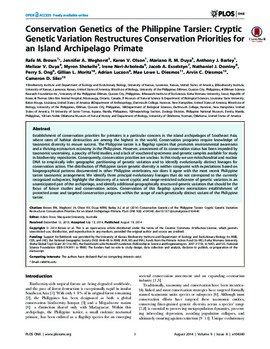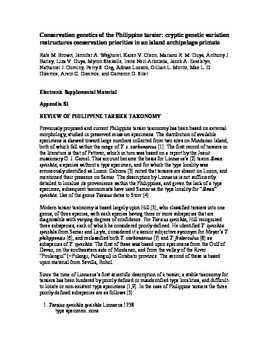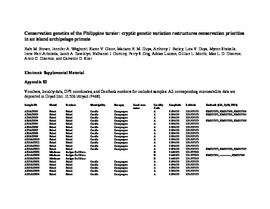| dc.contributor.author | Brown, Rafe M. | |
| dc.contributor.author | Weghorst, Jennifer A. | |
| dc.contributor.author | Olson, Karen V. | |
| dc.contributor.author | Duya, Mariano R. M. | |
| dc.contributor.author | Barley, Anthony J. | |
| dc.contributor.author | Duya, Melizar V. | |
| dc.contributor.author | Shekelle, Myron | |
| dc.contributor.author | Neri-Arboleda, Irene | |
| dc.contributor.author | Esselstyn, Jacob A. | |
| dc.contributor.author | Dominy, Nathaniel J. | |
| dc.contributor.author | Ong, Perry S. | |
| dc.contributor.author | Moritz, Gillian L. | |
| dc.contributor.author | Luczon, Adrian | |
| dc.contributor.author | Diesmos, Mae Lowe L. | |
| dc.contributor.author | Diesmos, Arvin C. | |
| dc.contributor.author | Siler, Cameron D. | |
| dc.date.accessioned | 2014-09-11T05:52:31Z | |
| dc.date.accessioned | 2016-03-30T15:31:04Z | |
| dc.date.available | 2014-09-11T05:52:31Z | |
| dc.date.available | 2016-03-30T15:31:04Z | |
| dc.date.issued | 2014-08-19 | |
| dc.identifier.uri | https://hdl.handle.net/11244/10819 | |
| dc.description | Acknowledgments
We thank the Philippine Department of Environment and Natural Resources for facilitating research, sample collection, and export permits (in particular T. M. Lim, C. Custodio, J. deLeon, and A. Tagtag) necessary for this and related research. Sampling protocols were approved by the University of Kansas Animal Care and Use Committee (IACUC 158-01 to RMB) and protocols to capture, sedate, and harvest ear biopsies from wild tarsiers were approved by the Dartmouth Animal Care and Use Committee (IACUC 10-11-12 and 11-06-06AT to NJD). Thanks are due to J. Quilang for assistance with data and comments on the manuscript. We thank N. Antoque, J. Cantil, and V. Yngente for assistance in the field and anonymous reviewers for comments on previous versions of the manuscript. | en_US |
| dc.description | Author Contributions
Conceived and designed the experiments: RMB JAW CDS JAE MS MLD ACD. Performed the experiments: RMB MRMD LVD INA JAE NJD PSO AL MLD ACD CDS. Analyzed the data: KVO AJB CDS. Contributed reagents/materials/analysis tools: RMB KVO AJB CDS JAE LVD GLM. Wrote the paper: RMB JAW CDS JAE MS GLM. Obtained permission and executed field surveys: RMB MRMD LVD MS INA JAE NJD PSO GLM AL MLD ACD CDS. | |
| dc.description.abstract | Establishment of conservation priorities for primates is a particular concern in the island archipelagos of Southeast Asia, where rates of habitat destruction are among the highest in the world. Conservation programs require knowledge of taxonomic diversity to ensure success. The Philippine tarsier is a flagship species that promotes environmental awareness and a thriving ecotourism economy in the Philippines. However, assessment of its conservation status has been impeded by taxonomic uncertainty, a paucity of field studies, and a lack of vouchered specimens and genetic samples available for study in biodiversity repositories. Consequently, conservation priorities are unclear. In this study we use mitochondrial and nuclear DNA to empirically infer geographic partitioning of genetic variation and to identify evolutionarily distinct lineages for conservation action. The distribution of Philippine tarsier genetic diversity is neither congruent with expectations based on biogeographical patterns documented in other Philippine vertebrates, nor does it agree with the most recent Philippine tarsier taxonomic arrangement. We identify three principal evolutionary lineages that do not correspond to the currently recognized subspecies, highlight the discovery of a novel cryptic and range-restricted subcenter of genetic variation in an unanticipated part of the archipelago, and identify additional geographically structured genetic variation that should be the focus of future studies and conservation action. Conservation of this flagship species necessitates establishment of protected areas and targeted conservation programs within the range of each genetically distinct variant of the Philippine tarsier. | en_US |
| dc.description.sponsorship | Support for fieldwork was provided by the University of Kansas Biodiversity Institute and Department of Ecology and Evolutionary Biology (to RMB, CDS, and JAE), the National Geographic Society (NGS 8446-08 to RMB, JAW, MS and INA), funds from the Primate Action Fund (to MS), Ewha Womans University (Ewha Global Top5 Grant 2013 to MS), the David and Lucile Packard Foundation (Fellowship in Science and Engineering no. 2007-31754, to NJD), and U.S. National Science Foundation (DEB 0743491 to RMB). The funders had no role in study design, data collection and analysis, decision to publish, or preparation of the manuscript. | en_US |
| dc.language | en_US | en_US |
| dc.relation.ispartofseries | PLoS ONE;9(8): e104340 | |
| dc.relation.uri | http://www.plosone.org/article/info%3Adoi%2F10.1371%2Fjournal.pone.0104340 | |
| dc.subject | Conservation genetics | en_US |
| dc.subject | Conservation science | en_US |
| dc.subject | Evolutionary genetics | en_US |
| dc.subject | Gene targeting | en_US |
| dc.subject | Mitochondria | en_US |
| dc.subject | Phiippines | en_US |
| dc.subject | Phylogeography | en_US |
| dc.subject | Population genetics | en_US |
| dc.title | Conservation Genetics of the Philippine Tarsier: Cryptic Genetic Variation Restructures Conservation Priorities for an Island Archipelago Primate | en_US |
| dc.type | Article | en_US |
| dc.description.peerreview | Yes | en_US |
| dc.description.peerreviewnotes | http://www.plosone.org/static/editorial#peer | en_US |
| dc.identifier.doi | doi:10.1371/journal.pone.0104340 | en_US |


